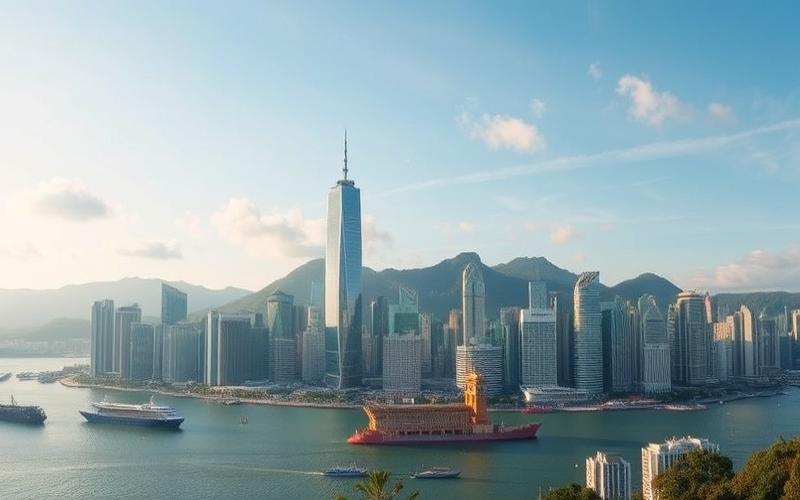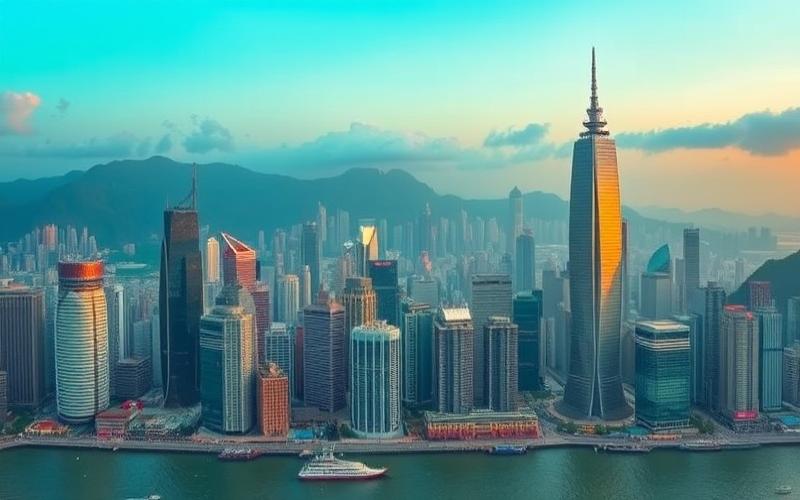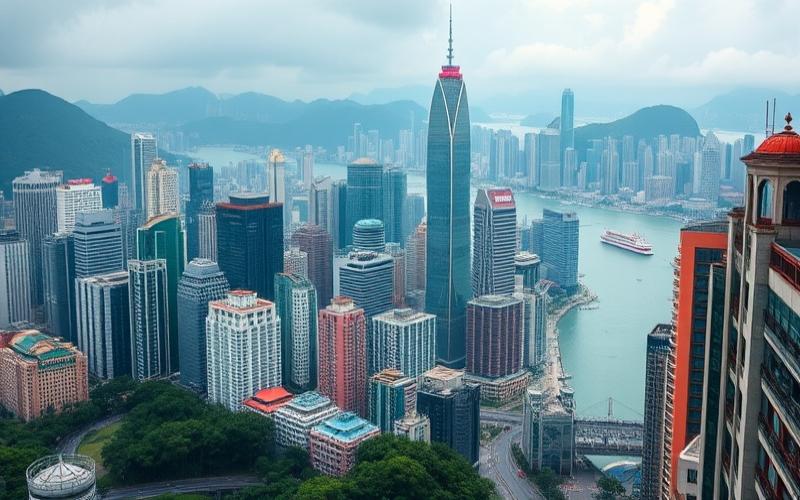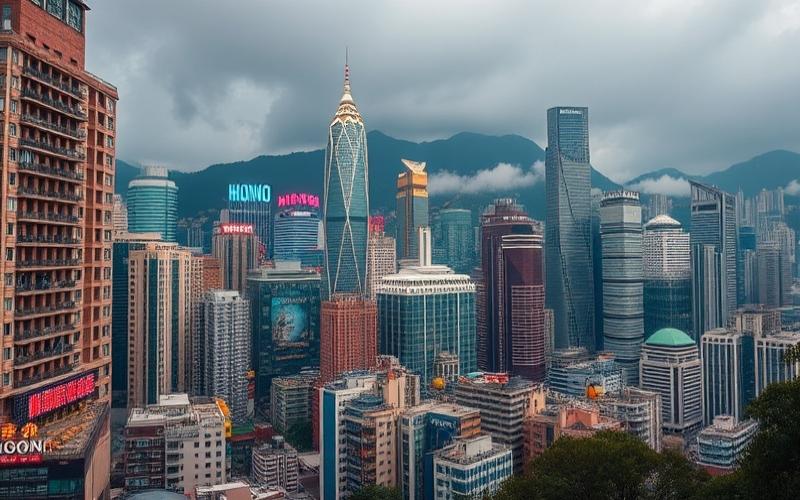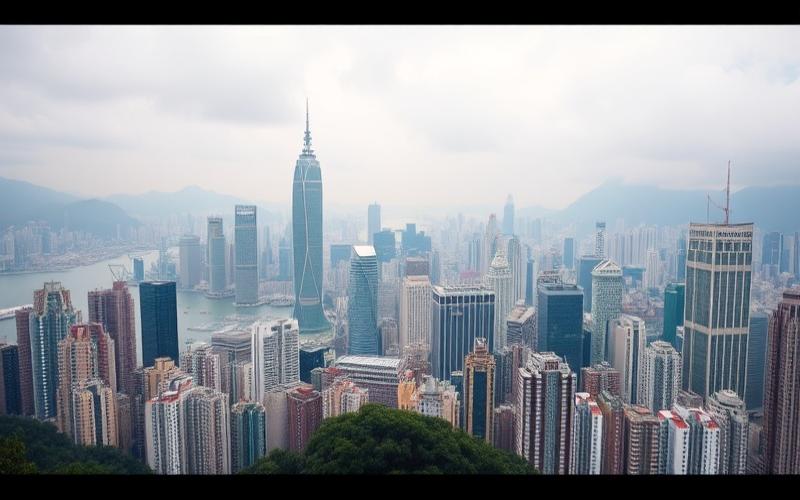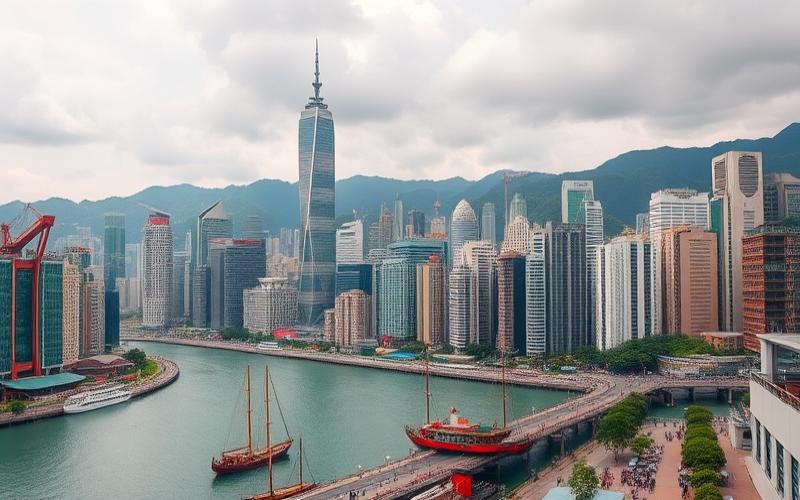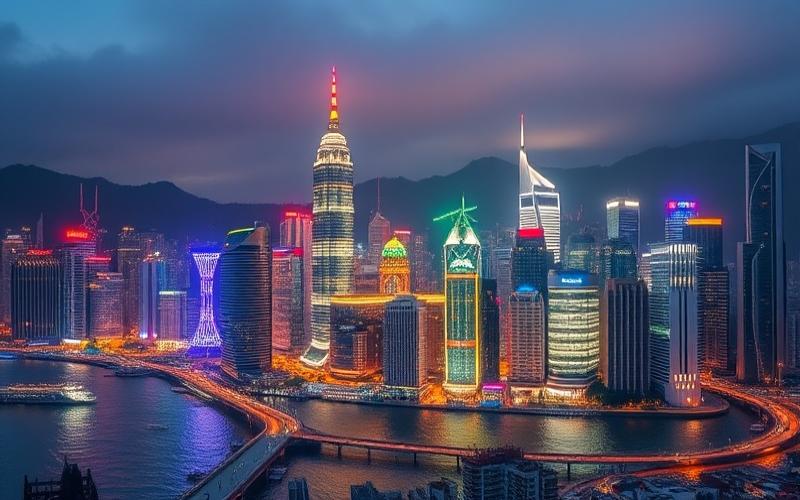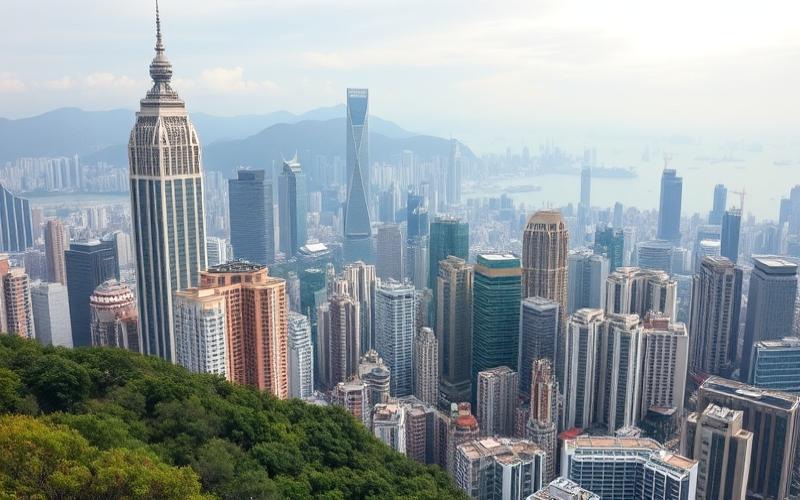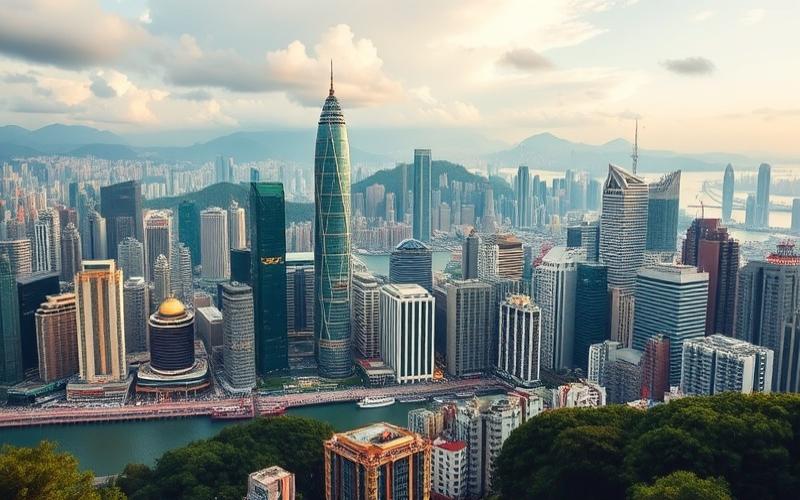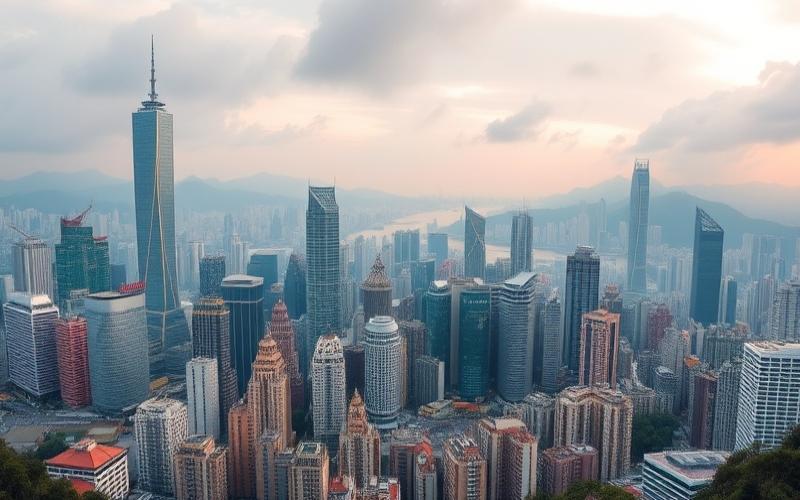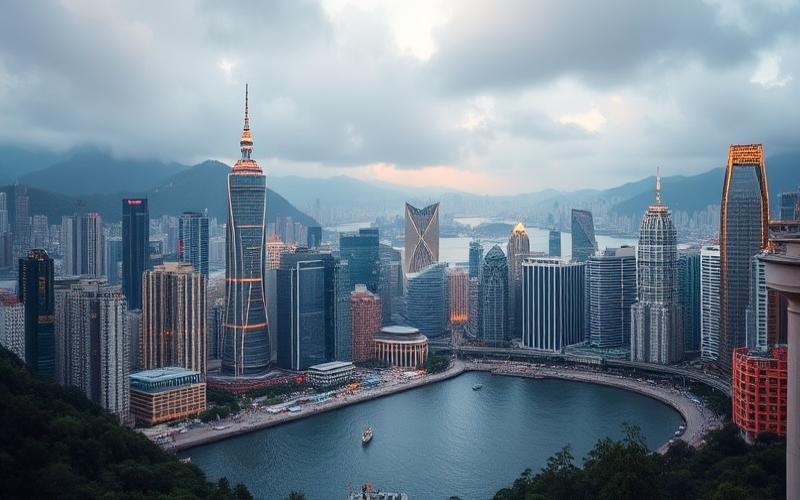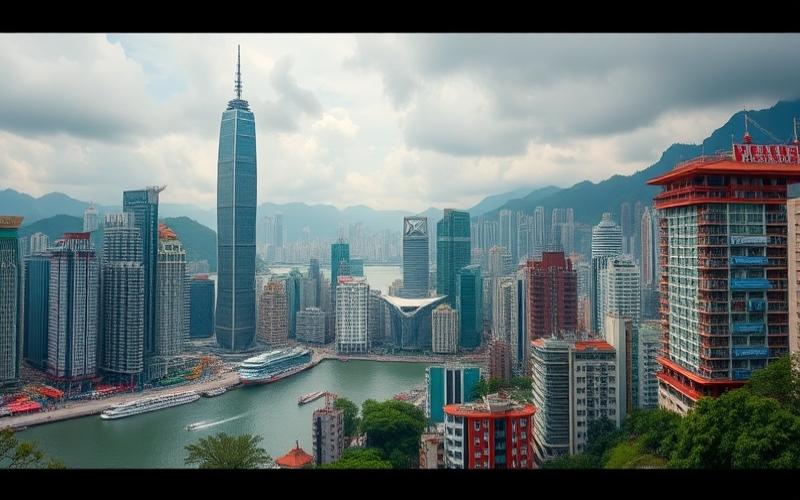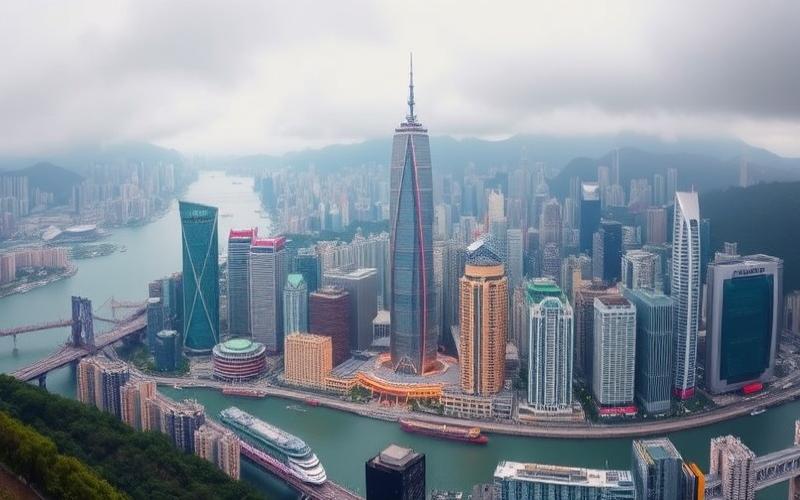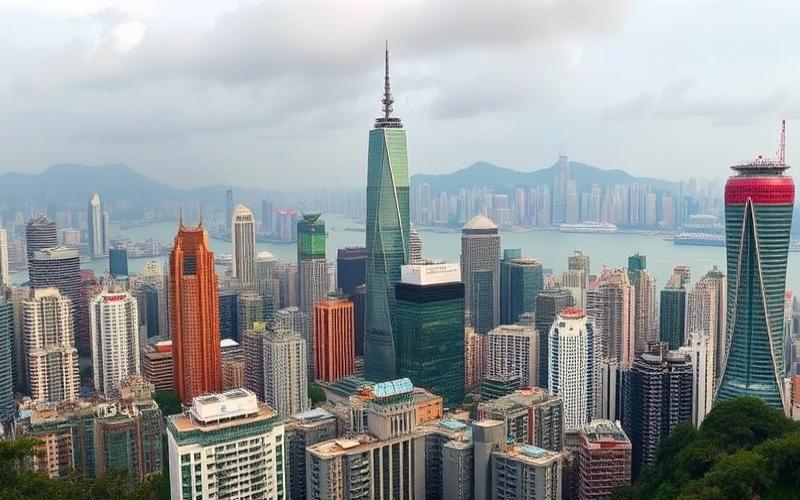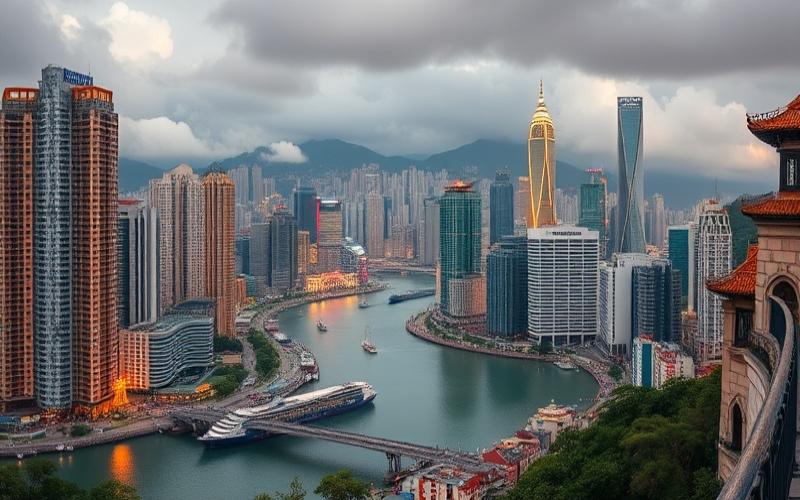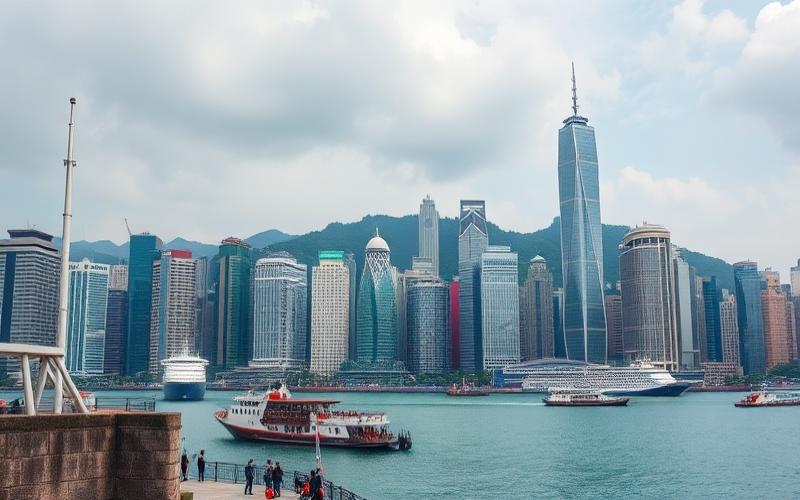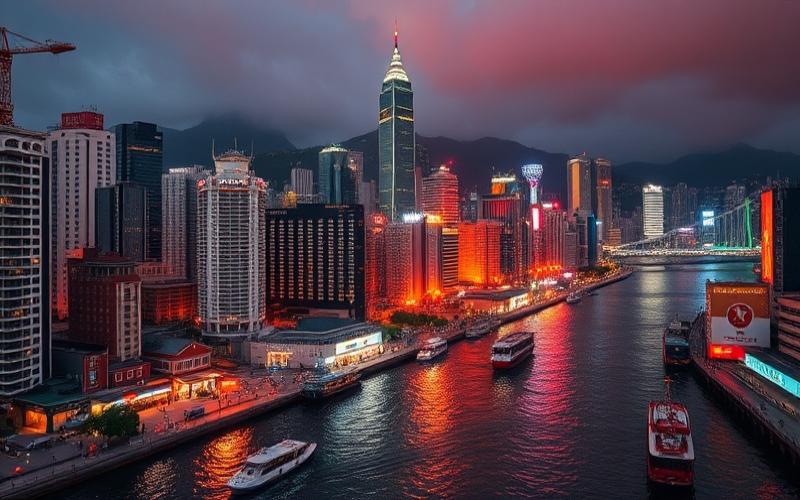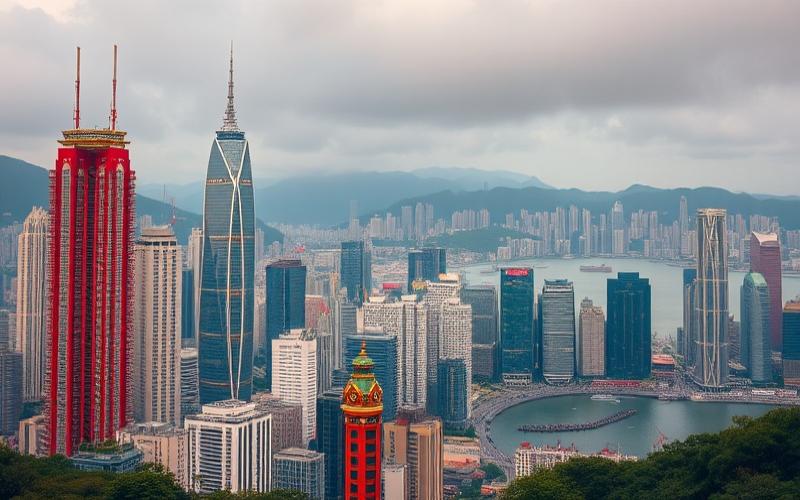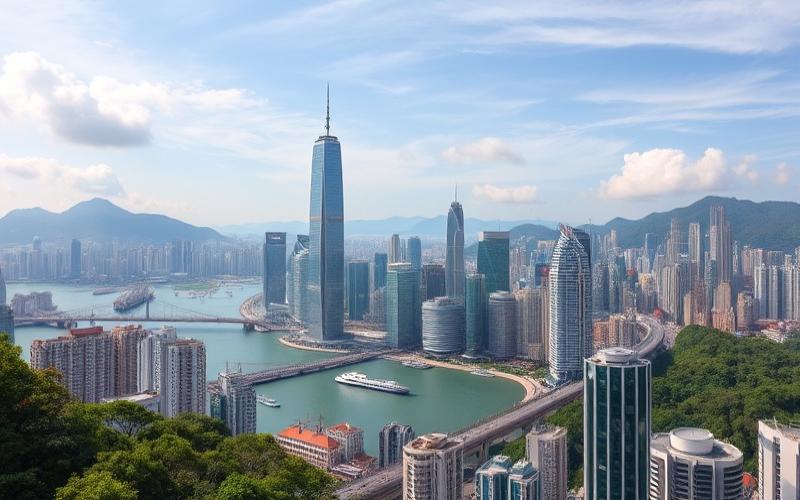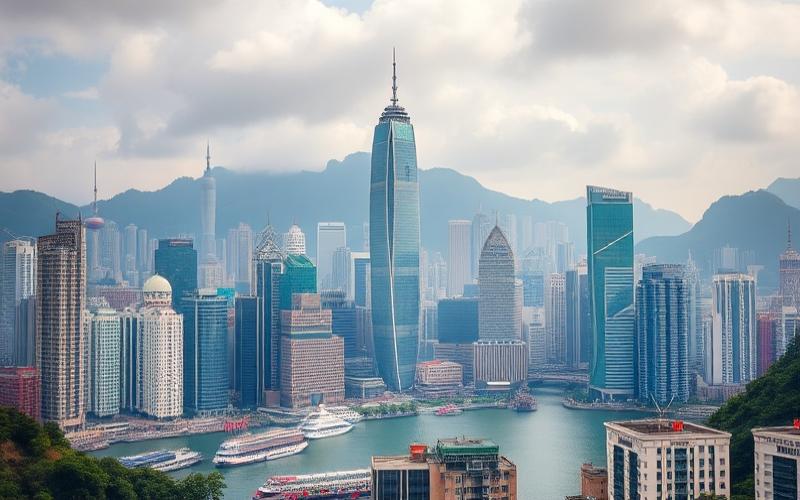
 Published on and written by Cyril Jarnias
Published on and written by Cyril Jarnias
Investing in Commercial Real Estate in Hong Kong
Hong Kong, renowned as one of the world’s financial capitals, offers a dynamic and ever-evolving landscape for those looking to explore commercial real estate investment opportunities.
With its strategic geographical position and role as a gateway between Asia and the rest of the world, Hong Kong attracts not only international businesses but also investors seeking attractive returns and portfolio diversification.
As the city evolves to meet the needs of modern industries, redevelopment projects and new infrastructure create unique opportunities that promise to transform the market.
By adopting an informed and strategic approach, investors can leverage this unique dynamic to achieve substantial gains in one of the world’s most competitive urban environments.
Good to Know:
Hong Kong benefits from a transparent legal framework that’s favorable to foreign investment, making it a preferred destination for commercial real estate.
Discovering Commercial Real Estate in Hong Kong
Hong Kong’s commercial real estate market in 2025 is characterized by oversupply, record vacancy rates, and continued pressure on rents, offering investors both opportunities and significant risks.
Recent Trends
- High Vacancy Rates:
- Offices: rates reaching 13.6% in H1 2025 (up to 19% in some districts).
- Retail: vacancy at 10.5% for luxury shopping centers and street-front stores.
- Continued Decline in Rents and Values:
- Commercial asset values expected to decline an additional 5-10% this year.
- Premium office rents: cumulative decline of approximately -41.4% since the 2019 peak.
- Significant New Office Supply Expected (~3.5 million net square feet expected for delivery this year), increasing downward pressure.
| Sector | Vacancy Rate (%) | Annual Value Change (%) | Annual Rent Change (%) |
| Offices | Up to ~19 | -5 to -10 | -2.5 (premium) |
| Retail (luxury) | ~10.5 | Not specified | -3.4 |
| Retail (street) | ~12 | Not specified | -2.3 |
| Logistics | ~10 | Not specified | -0.8 quarterly |
Preferred Investment Districts
- Central & Admiralty: Still preferred despite general decline; high concentration of premium buildings offering relative resilience.
- Tsim Sha Tsui & Causeway Bay: Heart of high-end retail with recent major projects like International Gateway Centre or One Causeway Bay.
- Kowloon East: Emerging district with modern buildings attracting “flight to quality” movement.
Main Types of Available Properties
- Prime buildings (“Grade A”), often with ESG certifications
- Shopping centers/high street retail
- Modern logistics warehouses
Influential Economic Data
Summary list:
- Overall office occupancy rate: approximately 80-87%
- Average prime office rental yields: between 2-3% depending on location
- Average Central Grade A office rental cost: around HKD $90-110/sq ft/month
- Premium logistics warehousing in Kowloon/NT: HKD $15-18/sq ft/month
Yields are under pressure due to widespread rent declines and limited demand outside very central areas.
Long-term Outlook & Risk Factors
Opportunities:
- Strategic repositioning possible due to supply surplus (“flight to quality”)
- New high-end projects allowing cost reduction/flexibility for end users
Risks:
- Persistent macroeconomic uncertainties related to global trade
- Lasting impact of remote work on traditional office demand
- Enhanced political/regulatory risk due to evolving Sino-international relations (possible increased regulatory pressure)
Recent Concrete Examples or Iconic Projects
| Project / Location | Type | Area |
| International Gateway Centre (TST) | Grade A Office | >2.1 M sq ft |
| One Causeway Bay | Prime Office | ~410 K sq ft |
| Cainiao Smart Gateway (Chek Lap Kok) | Warehouse/logistics | 100 K sq ft |
Key Takeaways
The current context favors tenants across all major segments due to abundant supply and increased flexibility during negotiations. Outlook remains uncertain on the political/regulatory front while the market’s structural transformation requires caution from investors seeking quick returns or stable valuations.
Good to Know:
Hong Kong’s commercial real estate market currently presents various investment opportunities, particularly in preferred districts like Central, Tsim Sha Tsui, and Kowloon East, where office and retail properties are especially sought after. Despite a slight slowdown due to political tensions and post-pandemic economic adjustments, occupancy rates remain high, around 89%, and rental yields competitive, often above 3%. The average rental cost for prime offices reaches 1300 HKD per square foot, but more affordable opportunities are also emerging in Kai Tak and other developing areas. Flagship projects like Gaw Capital’s Hongkong Land in Central demonstrate the market’s resilience, although investors should pay attention to changing regulations and the impacts of potential interest rate increases. Long-term, economic reforms and Hong Kong’s role as Asia’s financial hub support generally positive prospects for commercial real estate.
Exploring Key Commercial Properties
Most Sought-After Commercial Property Types in Hong Kong
- Grade A Office Spaces: These modern, highly-equipped buildings concentrate demand from major international financial corporations.
- Shopping Centers and Street-Front Stores (High Street Shops): Shopping areas, particularly in central districts, attract both global brands and local retailers.
- Industrial/Logistics Facilities: Rapidly evolving with e-commerce growth and asset repositioning to meet new logistics needs.
| Property Type | Main Districts | Recent Trends |
|---|---|---|
| Office Spaces | Central, Quarry Bay, Tsim Sha Tsui | Supply surplus; declining rents; “flight to quality” |
| Shopping Centers | Causeway Bay, Central, Tsim Sha Tsui, Mong Kok | Slight rent recovery in some key sectors; adaptation to e-commerce growth |
| Industrial Facilities | Kwai Chung, Tsuen Wan | Warehouse conversion for urban logistics |
Main Growing or Transforming Districts/Areas
- Central (CBD) & Admiralty: Still at the center of international financial flows. Activity supported by strong IPO pipeline.
- Quarry Bay & Kowloon East (Kwun Tong/Tseung Kwan O): Rapid growth due to modern infrastructure and development of recent buildings with competitive rents.
- Tsim Sha Tsui & Causeway Bay: Major hubs for high-end retail and dining; foot traffic boosted by tourism recovery.
- Kwai Chung/Tsuen Wan/Yuen Long/Tuen Mun: Strategic industrial areas benefiting from logistics development.
Factors Influencing Prices and Demand
- Increased infrastructure development (new MTR lines/road network expansion).
- Government policies facilitating foreign capital inflow (recent example: simplified re-domiciliation regime for foreign companies).
- Abundant office segment supply (+3.5 million net sq ft expected in 2025), reinforcing tenant-favorable market with availability reaching up to 22%.
- Increased adaptation to ESG criteria: green buildings sought by international institutional investors.
Features Sought by Investors
- Strategic location near public transportation
- Contract flexibility
- Stable rental yield or appreciable post-renovation potential
- ESG compliance/environmental certifications
Challenges Faced
- High competition among landlords due to significant increase in available stock
- Complex regulations for major mixed-use projects or industrial conversions
- Rapid evolution of consumption patterns requiring constant adaptation
Recent Concrete Examples
| Project/Property | Location | Distinctive Features |
|---|---|---|
| International Gateway Centre | Tsim Sha Tsui | +2.1M sq ft new Grade A office space delivered |
| One Causeway Bay | Causeway Bay | Premium building focused on flexibility/ESG |
| New F&B spaces | Mong Kok/Central | Strong post-pandemic expansion |
Hong Kong’s market is currently characterized by oversupply in office/retail segments with downward pressure on rents, but thus offers a unique strategic window to reposition real estate investments toward greater energy efficiency, rental flexibility, and prime location in an unstable global context.
Good to Know:
In Hong Kong, key commercial properties mainly include office spaces, shopping centers, and industrial facilities, with districts like Central and Kowloon West booming. Central is specifically sought after for its high-end office spaces, while Kowloon West is increasingly attracting investors due to recent infrastructure developments. Trends show that demand remains strong despite price volatility, influenced by factors such as the government’s pro-business policies and the inflow of international capital. Investors often favor projects with good development potential and modern infrastructure, but must navigate cautiously given intense competition and strict local regulations. For example, the recent West Kowloon Cultural District project illustrates the growing demand for multi-purpose spaces integrating cultural and commercial components.
Analyzing Profitability and Potential Risks
Analysis of Commercial Real Estate Investment Profitability in Hong Kong (2025)
Market Trends and Fundamentals
- Demand and Supply
- Grade A office rental demand increased in transaction area, reaching 1.2 million square feet in H1 2025, a peak since the pandemic. However, rents continue to decline, with a 3.4% drop over the semester, due to abundant supply and tenant reorganization.
- In the industrial sector, rental demand has significantly weakened, with H1 2025 new lease volume being the lowest in ten years. Warehouse vacancy rate reaches 10.3%, increasing, leading to continued decline in industrial rents.
- The retail market remains stable but fragile: store openings and closures balance out, rents only slightly increase in main streets, while vacancy rises in central districts.
- Occupancy Rates
- Vacancy rates remain high across several segments:
- Warehouses: 10.3%
- Grade A Offices: increasing, persistent pressure on rents
- Downtown Retail: rising vacancy, despite tourism recovery
- Vacancy rates remain high across several segments:
- Rental and Sale Prices
- Grade A Offices: rents expected to decline 7-9% for 2025
- Industrial: sixth consecutive quarter of rent decline, -2.9% annually
- Retail: rents projected to decline 0-5% in 2025
- Capital Values:
- Grade A Offices: -9.8% in 2024
- Street Retail: -1.6%
- Warehouses: -7.4%
Regulations, Tax Incentives and Public Policies
- Regulation
- 2024 policy includes facilitation of hotel and commercial building conversions to student housing, which could boost demand for certain office and hotel assets.
- Incentives include simplified procedures, certain tax exemptions, and zoning relaxations to encourage existing asset transformations.
- Taxation
- No major new tax incentives in 2025. However, investors benefit from relatively stable taxation compared to other Asian markets.
Economic Projections and Outlook
Macroeconomic Context
HIBOR rate has significantly decreased (from 3.73% to 0.72% between March and June 2025), reducing financing costs, but investment demand remains moderate, lacking rapid growth prospects in an uncertain global context.
Commercial asset values are expected to decline another 5-10% in 2025, offering opportunities for opportunistic investors, but signaling a deflationary environment.
Major Risks for Investors
| Main Risk | Description | Potential Impact |
|---|---|---|
| Global Economic Fluctuations | Dependence on international conditions, exports, and US monetary policy | Demand decline, volatility |
| Legislative Changes | Changes in taxation, zoning, or conversion regulations | Valuation uncertainty |
| Real Estate Market Volatility | Continued decline in prices and rents, rising vacancy rates | Reduced short-term profitability |
| International Political Relations | Sino-American tensions, geopolitical uncertainties | Risk to stability of flows |
| Refinancing Risk | Difficulty refinancing assets at high rates if values decline or liquidity tightens | Forced sale, potential losses |
Case Studies and Opportunities
- Office to Student Housing Conversion: Some Grade B office buildings could gain attractiveness if regulations facilitate their transformation, creating value for currently depreciated assets.
- Opportunistic Investment: With prospect of further price declines, investors with liquidity could acquire discounted assets, betting on medium-term rebound.
- Logistics Sector: Despite current decline, adaptation to e-commerce demand and specialization (storage for London Metal Exchange, for example) could offer yield niches.
Summary of Key Indicators (2025)
| Segment | Vacancy Rate | Rent Change | Price Change | Demand Trends |
|---|---|---|---|---|
| Grade A Offices | High | -7 to -9% | -9.8% | Relocation, overall decline |
| Warehouses/Logistics | 10.3% | -2.9% annual | -7.4% | Weak, increased caution |
| Main Street Retail | Increasing | -0 to -5% | -1.6% | Selective recovery, caution |
Points to Monitor for Investors
- Prioritize detailed analysis by sub-segment and location.
- Consider value-added assets (conversion, repositioning).
- Monitor HIBOR evolution, public policies, and regional geopolitical context.
- Diversify to limit exposure to local market risk.
Hong Kong’s market currently offers potential for opportunistic investors, but caution remains warranted given prolonged price correction and uncertain macroeconomic environment.
Good to Know:
Investing in Hong Kong commercial real estate offers attractive profitability due to strong demand, particularly in strategic areas like Central and Tsim Sha Tsui, where occupancy rates remain high. Currently, rental and sale prices are supported by limited supply, although strictly regulated by local regulations. Tax incentives and positive economic prospects generate interesting opportunities, but it’s crucial to consider potential risks. Global economic fluctuations, evolving trade policies, and possible real estate market volatility influenced by geopolitical tensions can impact return stability. Recent case studies show that portfolio diversification into other real estate segments or regions can mitigate some of these risks.
Demystifying Current Market Trends
Analysis of Economic Factors Influencing Hong Kong’s Commercial Real Estate Market
The continued decline in commercial property values and rents is manifested by record vacancy rates in the office sector (13.6% in H1 2025) and cumulative depreciation of 41.4% in premium office rents since 2019.
This situation is explained by:
- Recent changes in government policies, including relaxation of certain real estate restrictions and demand stimulation via lower interest rates (declining HIBOR).
- Strength of the Hong Kong dollar, which penalizes competitiveness.
- Regional economic stability under pressure from Chinese slowdown and geopolitical tensions.
Investors are adopting a wait-and-see approach, despite some transaction recovery, given supply abundance and moderate demand.
Evolution of Consumption Trends and Impact on Real Estate Development
- Changes in consumption patterns (e-commerce growth, experience seeking, work flexibility) lead to:
- Rise of coworking spaces, favored by flexibility sought by companies and labor market volatility.
- Development of next-generation shopping centers, betting on entertainment, dining, and digital technology integration to attract visitors.
- High vacancy in traditional shopping centers pushes owners to rethink offerings and diversify tenants.
Influence of Emerging Technologies and Sustainability Imperatives
Construction and real estate management practices are rapidly evolving:
- Adoption of smart building management: IoT sensors for energy efficiency, predictive maintenance, system automation.
- Environmental certification (LEED, BEAM Plus) increasingly required by institutional investors.
- Integration of green mobility solutions and electric vehicle infrastructure.
Focus is on reducing carbon footprint and optimizing energy consumption.
Impact of COVID-19 Pandemic on Supply and Demand
The pandemic accelerated:
- Usage transformation: widespread remote work, decreased demand for traditional office space, search for rental flexibility.
- Retailer and occupant focus on high-traffic or value-added locations, to the detriment of secondary areas.
- More cautious investor behavior, favoring resilience and portfolio diversification.
Supply remains abundant, creating continued pressure on rents and favoring tenant “reshuffling”.
Promising Districts and Geographical Areas for Investment
| District/Area | Main Opportunities | Current Dynamics |
|---|---|---|
| Central & Admiralty | Premium offices, financial services | Rent pressure, but strong long-term resilience |
| Kowloon East (Kwun Tong, Kai Tak) | Redevelopment projects, innovation hubs | Modern office supply, proximity to new transportation |
| West Kowloon | Shopping centers, connectivity | Benefits from new high-speed rail station and urban developments |
| Wong Chuk Hang & Island South | Creative spaces, flexible offices | Industrial transformation into mixed-use zone, growing attractiveness |
Transport infrastructure development projects (MTR extensions, cross-border links) are crucial for future district valuation.
Recommendations for Investors
Carefully study regulatory context:
- Consider recent relaxations, but anticipate tax developments and foreign investment constraints.
- Inform yourself about environmental standards and ESG reporting requirements.
Prioritize:
- Resilient assets adapted to new trends (coworking, experiential retail, urban logistics).
- Areas benefiting from public infrastructure investments and structural attractiveness.
Diversify strategies:
- Choose between direct acquisition, partnerships with local operators, or investment via collective vehicles (REITs).
- Integrate cautious approach given interest rate volatility and possibility of continued price correction.
Key takeaway: Hong Kong’s commercial real estate market is undergoing a profound transformation phase, marked by value adjustment, usage evolution, and rise of technological and sustainability challenges. Opportunities exist, but require selectivity, innovation, and adaptation to the new regulatory context.
Good to Know:
Hong Kong’s commercial real estate market is influenced by economic elements such as adjustments in government policies, interest rate fluctuations, and regional stability. Consumption trends are evolving, promoting innovative concepts like coworking spaces and high-end shopping centers, which develop as work and shopping practices change. Emerging technologies and ecological imperatives inspire new construction and management methods, while the pandemic transformed market dynamics, altering supply and demand, and prompting investment reevaluation. Districts like Kowloon East benefit from expanding infrastructure, making certain neighborhoods particularly attractive for investment. Investors must nevertheless familiarize themselves with Hong Kong’s regulatory specificities, where good understanding of the tax framework can offer considerable advantages.
Disclaimer: The information provided on this website is for informational purposes only and does not constitute financial, legal, or professional advice. We encourage you to consult qualified experts before making any investment, real estate, or expatriation decisions. Although we strive to maintain up-to-date and accurate information, we do not guarantee the completeness, accuracy, or timeliness of the proposed content. As investment and expatriation involve risks, we disclaim any liability for potential losses or damages arising from the use of this site. Your use of this site confirms your acceptance of these terms and your understanding of the associated risks.

